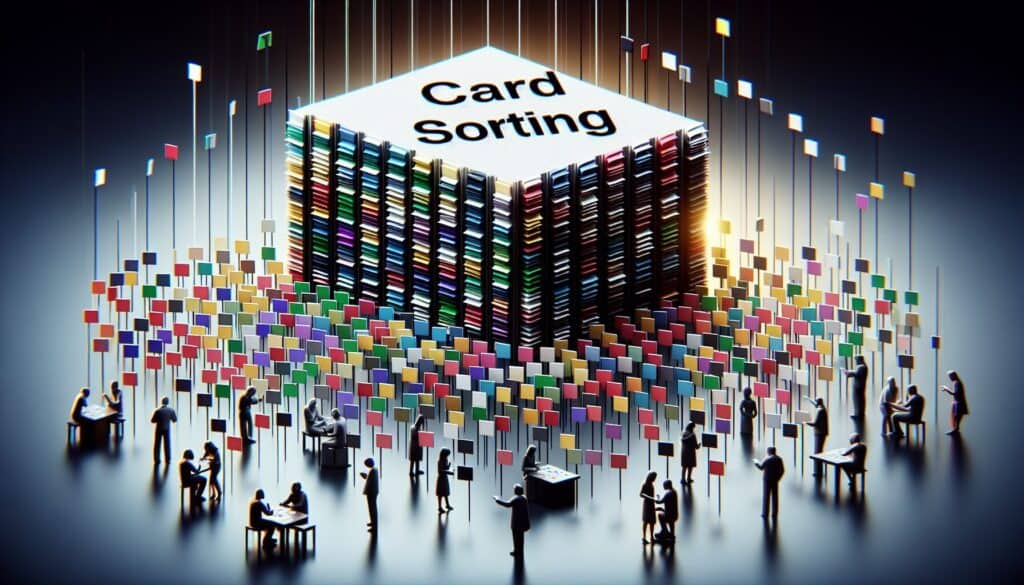To understand how users group information and what labels make sense to them, in order to design intuitive architecture de l'information.
- Méthodologies : Ingénierie, Qualité
Card Sorting

Card Sorting
- Pensée conceptuelle, Conception centrée sur l'humain, Architecture de l'information, Conception d'interaction, Utilisabilité, Tests d'utilisabilité, Interface utilisateur (UI), Tests auprès des utilisateurs
Objectif :
Comment il est utilisé :
- Participants are given a set of cards with topics or items and are asked to group them in a way that makes sense to them and then label these groups.
Avantages
- Relatively simple and inexpensive to conduct; provides direct insight into users' mental models; can be done online or in person.
Inconvénients
- Results can be influenced by participant selection; analysis can be time-consuming for open card sorts; may not reveal deeper contextual needs.
Catégories :
- Clients et marketing, Conception de Produits
Idéal pour :
- Designing or evaluating the information architecture of websites, apps, or software.
Card Tri can be particularly valuable during the early phases of product development, especially in projects focused on user experience design and information architecture. It is often utilized in industries such as e-commerce, education technology, and content management systems where organizing information effectively enhances user engagement and satisfaction. During this methodology, participant feedback can reveal patterns in how users categorize information, which can inform navigation structures and labeling conventions. For instance, a digital marketplace might employ Card Sorting to determine how customers intuitively group products, enabling more efficient search functionalities and filtering options within the platform. This approach invites a diverse range of participants, including end-users, product managers, designers, and content strategists, to collaborate in shaping the site’s structure. It can also be adapted to various contexts, whether conducted as a remote online activity or in structured workshops, allowing for flexibility in gathering qualitative data. The simplicity of Card Sorting not only reduces costs involved in extensive usability testing but also accelerates the iterative design process by swiftly gathering user feedback that can be analyzed and implemented in subsequent drafts of the digital product. Applying the insights gained from this methodology can lead to a more intuitive user interface, ultimately enhancing the overall experience of using the application or website.
Principales étapes de cette méthodologie
- Distribute cards with topics or items to participants.
- Instruct participants to group the cards in a way that makes sense to them.
- Ask participants to label the groups they created.
- Encourage participants to explain their reasoning behind the groupings and labels.
- Observe and note patterns in groupings across multiple participants.
Conseils de pro
- Incorporate demographic data analysis to understand variations in grouping patterns among different user segments.
- Utilize card sorting results in conjunction with usability testing to validate information architecture choices within the context of user tasks.
- Implement iterative rounds of card sorting with evolving card sets to refine categories and assess their relevance over time.
Lire et comparer plusieurs méthodologies, nous recommandons le
> Référentiel méthodologique étendu <
ainsi que plus de 400 autres méthodologies.
Vos commentaires sur cette méthodologie ou des informations supplémentaires sont les bienvenus sur le site web de la Commission européenne. section des commentaires ci-dessous ↓ , ainsi que toute idée ou lien en rapport avec l'ingénierie.
Contexte historique
1986
(si la date est inconnue ou n'est pas pertinente, par exemple "mécanique des fluides", une estimation arrondie de son émergence notable est fournie)

Articles Similaires
Calculateur de METS en calories
Méta-analyse
Cartographie des messages
Diagrammes du modèle mental
Forces de poussée et de traction maximales acceptables
Planification des besoins en matériaux (MRP)